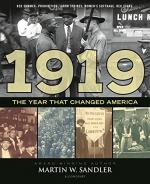
|
| Name: _________________________ | Period: ___________________ |
This test consists of 5 multiple choice questions, 5 short answer questions, and 10 short essay questions.
Multiple Choice Questions
1. Sandler writes, "Communism is based on a system in which" what entity "owns everything and is responsible for distributing resources to every citizen" (96)?
(a) The government.
(b) The church.
(c) The king.
(d) The individual.
2. The leader of the new bureau named the General Intelligence Division created a filing system containing how many hundreds of thousands of "cross-indexed cards" (100)?
(a) 2.
(b) 8.
(c) 4.
(d) 6.
3. In what year was the 15th Amendment ratified, granting black men the right to vote?
(a) 1890.
(b) 1910.
(c) 1870.
(d) 1929.
4. According to the prestigious organization called Equal Justice Initiative (EJI) how many black people were killed during the Elaine Massacre?
(a) 237.
(b) 58.
(c) 34.
(d) 111.
5. Just under how many years after the first Red Scare in America did the second Red Scare take place?
(a) 70.
(b) 30.
(c) 20.
(d) 50.
Short Answer Questions
1. How many black citizens lived in Forsythe County, Georgia at the beginning of 1919?
2. In what year did Senator Joseph McCarthy's first event aimed at inciting a second Red Scare take place?
3. How many black citizens lived in Forsythe County, Georgia by the end of 1919?
4. Sandler states that those "who carried out lynchings made certain that, whenever possible, they were" what kind of "spectacle" (71)?
5. In what month did Senator Joseph McCarthy host his first event aimed at exploiting the rising fear of Communism in America?
Short Essay Questions
1. Who was the leader of the second Red Scare and when did it occur?
2. Discuss an example of irony Sandler points out within a particular historical event.
3. Who was the leader of the first Red Scare?
4. In which three American cities did the three "largest and most devastating riots of all take place" (72) during the period called the Red Summer?
5. What is the significance of the date January 2, 1920?
6. In what way are American freedoms shown to have ebbed during the first Red Scare?
7. Who coined the phrase the Red Summer and why?
8. In what way is the phrase "race riot" (68) misleading when it comes to a period of time like the Red Summer of 1919?
9. What is the philosophy behind Communism and why are its results so often less than idyllic?
10. How were the expectations of black American soldiers dashed when they returned from fighting in World War I?
|
This section contains 890 words (approx. 3 pages at 300 words per page) |

|




